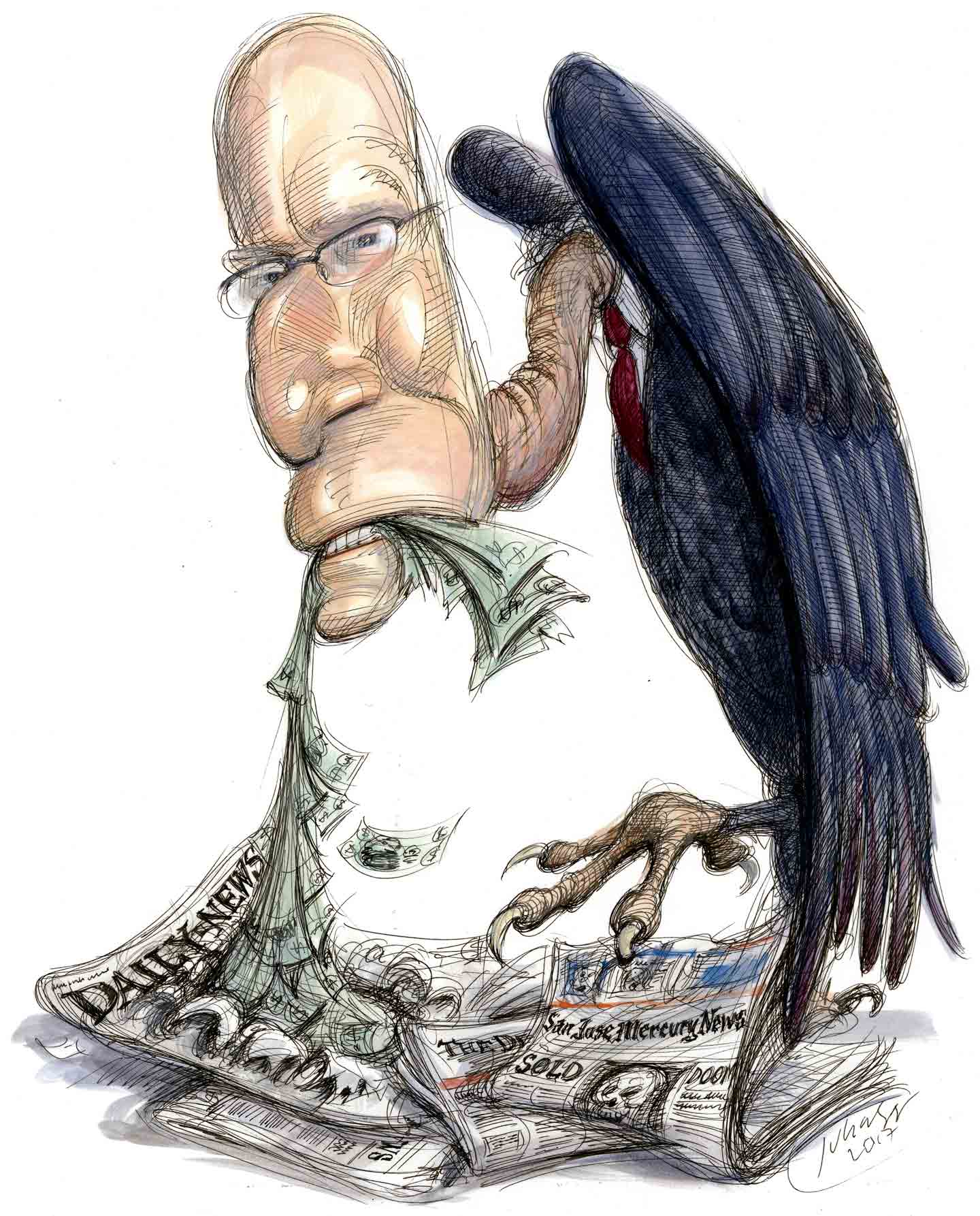As many as destroying America’s hometown newspapers can buy him.

In 2013, a reclusive New York tycoon and his wife began buying up expensive Palm Beach real estate—lots of it. First they bought seven mansions for a total of $23 million. Then another four “moderately priced” homes for $8.4 million. Then five more for $23 million. None of them were purchased in the tycoon’s name. They weren’t purchased in his wife’s name, either. Instead, the homes were deeded to limited-liability companies, including L. Jakes LLC and 124 Coconut Row LLC. Think of those luxury homes as the shuttered offices and fired workers of hometown newspapers across the United States, because gutting those newspapers helped make spending $57.2 million on 16 Palm Beach mansions a trifling expense for the tycoon.
His spending spree began after the tycoon acquired two firms, the Journal-Register and MediaNews Group, which would merge into one of America’s largest newspaper chains, Digital First Media. It continued under the veil of yet more limited-liability companies that likewise owned luxury homes. The only thing linking all these purchases was the same postal address in Manhattan’s glamorous Lipstick Building. There, within the tycoon’s privately held investment firm, his personal real-estate deals were commingled with the sales of scores of newsrooms, printing plants, and office buildings that previously belonged to small hometown newspapers across the United States.
The tycoon continued to finance his lavish lifestyle by purchasing and then destroying newspapers. His henchmen—young executives in expensive suits with no experience in the news business—laid off hundreds of journalists and other news workers. They ultimately closed or radically downsized such venerable papers as the Oakland Tribune, the San Jose Mercury News, the St. Paul Pioneer Press, and The Denver Post. At the Mercury News, the newspaper’s printing press was literally dismantled and carted away, which one staff reporter likened to “watching a heart being ripped out.”
The tycoon behind all this private profit and public destruction is Randall D. Smith, a seasoned Wall Street operator in his mid-70s who shuns publicity. Smith is the founder and chief of investments at Alden Global Capital, which manages $2 billion worth of assets. He has no experience with actually managing a newspaper, and his professional history reflects no interest in journalism beyond profiteering. Rather, he is what is known on Wall Street as a “vulture capitalist.” Or, as he prefers to phrase it in one of the company’s brochures, Smith invests in “distress.”
“Distress” is an apt word for the current state of America’s newspapers, and Smith isn’t the only financial mogul gobbling them up. On September 4, the New York Daily News was purchased by Tronc, the media conglomerate whose majority shareholder is Michael W. Ferro, the business magnate who founded the investment firm Merrick Ventures.
The shrinking and disappearing of hometown newspapers has done incalculable damage to Americans’ knowledge of the world around them. Democratic self-governance presumes an informed public, but the -hollowing-out of America’s newspapers, in both their online and print versions, leaves citizens increasingly ignorant of vital public matters. It also undermines the press’s ability to hold elected officials and powerful interests to account. When vulture capitalism eliminates reporters and closes hometown papers, where can citizens turn for in-depth local news? Who will cover City Council meetings, school-board decisions, election campaigns, and other staples of civic life? And who will call out corruption and incompetence on the part of local officials or private companies?
The most commonly cited culprit for the decline of America’s newspapers is the Internet and the assumption that no one needs to pay for news anymore. But simple capitalist greed is also to blame. Since 2004, speculators have bought and sucked dry an estimated 679 hometown newspapers that reached a combined audience of 12.8 million people....MUCH MORE
Unlike large corporate owners in the past, the stated goal of the investment firms is not to keep struggling newspapers alive; it is to siphon off the assets and profits, then dispose of what little remains. Under this strategy, America’s newsrooms shriveled from 46,700 full-time journalists in 2009 to 32,900 in 2015—a loss of roughly one journalist out of every three. The American Society of Newspaper Editors stopped trying to estimate the number of working journalists in 2016 because “layoffs, buyouts, and restructuring are a norm.”...